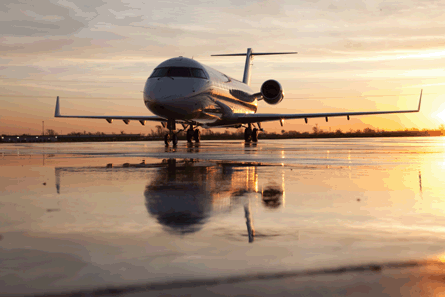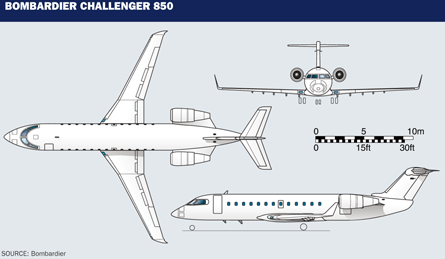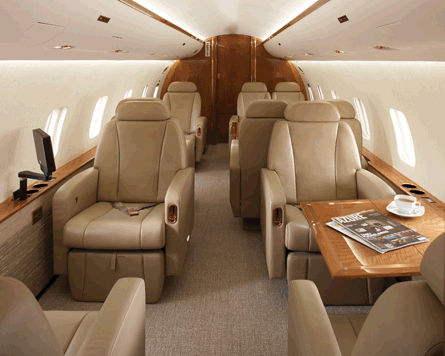Economy of scale for business jets takes on new dimensions when the subject is Bombardier's Challenger 850 executive jet, a forward fit 14-passenger version of the venerable 50-seat CRJ200 regional jet.
Along with a couple dozen "corporatised" CRJs completed before Bombardier launched the formal Challenger 850 programme in 2005, the 55 "official" 850s share manufacturer and PMA parts, service centres, mechanic expertise, an already-trained pilot pool and other money-saving elements with about 1,000 CRJ200s and CRJ100s still in service around the world.
 |
|---|
© Bombardier |
Bombardier stopped building the 50-seat regional jets in 2006 when it began producing the Challenger 850 on the same line in Montreal, saving a great deal of investment in non-recurring costs for its "new" jet. The CRJ200 featured the same airframe as the CRJ100 but has upgraded GE CF34-3B1 engines (see cutaway)
"The value proposition for the Challenger 850 is that you're buying reliability and a support network that is second to none," says Andy Nureddin, Bombardier's vice-president of customer services and support for business aircraft. "The price point is the right point in today's world."
For that price - $31.86 million in 2009 dollars - the buyer gets the ubiquitous support network plus an industry-leading three-zone, 2.5m (8.2ft)-wide, stand-up cabin on par with the Bombardier Global Express, but at almost $10 million less cost.
In another tip of the hat to the aircraft's airline heritage, operators can also find a ready supply of pilots skilled at flying the 850, given that the same type rating applies to the CRJ100/200, Challenger 604 business jet and Challenger 850.
PARAMETERS
The customer does not get certain performance parameters of the more expensive aircraft, nor does Bombardier promise as much.
Designed as an airliner, the Challenger 850 performs like an airliner. Range is relatively short, although is boosted to 5,525km (2,985nm) with four passengers from 3,145km for the longest-range CRJ200, thanks to the extra 1,800kg (3,965lb) of fuel in the 850's rear fuselage auxiliary fuel cells (F12).
 |
|---|
Take-off at the aircraft's gross take-off weight of 24,040kg at sea level and standard temperature conditions requires 1,920m, while at hot and high conditions at 5,000ft field elevation and 25°C (77°F), the aircraft demands more than 11,000ft, crimping the carriage of fuel and payload, hence range and utility.
The physics does not scare off potential customers as much as it focuses who buys it and where they want to fly. Europe and Russia are popular selling regions, because as one former Bombardier executive puts it, "Europe has shorter trips and longer runways".
"It's definitely a niche aircraft," admits Marc St-Georges, Bombardier's head of product planning and strategy for the Challenger 605 and 850. "We're meeting a market need for someone who doesn't require the range, but who wants an executive cabin feel." Comparison with Embraer's Legacy 600, a $25 million corporate version of the ERJ-135 regional airliner, make the value proposition clear: the 850 offers 41% more cabin area.
CABINS
Woven into those Challenger 850 cabins, along with multiple sections of club seating, a three-place berthable divan, a forward galley and aft lavatory and wardrobe, is an airborne office suite that includes two high-speed data Swift 64 channels for high-speed data communications, an Iridium airborne telephone system, three recessed 15in (38.1cm) LCD monitors (E26) on bulkheads for displaying Rockwell Collins Airshow 410 and Airshow 4000 content, two DVD players and one CD player.
Bombardier builds the green aircraft at the Dorval plant in Montreal, installing the extra fuel tanks in the aft section of the fuselage. Along with the Challenger 850, Bombardier in 2005 also launched two other airliner-to-business jet programmes, the Challenger 870 and Challenger 890, based on the 70- and 90-seat CRJ700 and CRJ900. Bombardier has since discontinued all conversions except for the Challenger 850.
 |
|---|
© Project Phoenix |
Challenger 850 completions are handled by Jet Aviation subsidiary, Midcoast Aviation in Illinois, although customers have the option of choosing their own finishing location for green aircraft. Rodger Renaud, senior vice-president of completions at Midcoast, says the company has 10 aircraft undergoing completions, up significantly from a typical rate of about three aircraft per six- to seven-month completion cycle.
Renaud says the company is in the initial stages of developing cabin upgrades to save weight, increase range and "make it look better and perform better". The upgrades could be available in about six months, he says.
Bombardier initially used Midcoast and Lufthansa Technik (LHT) in Hamburg for the completions, although the relationship with Lufthansa ended in April 2008 after 12 aircraft were completed. Bombardier says the split was mutually agreed upon between the two companies as LHT wanted to concentrate on larger jets.
AVIONICS
Customers do not appear to be bothered by the heritage six-CRT Rockwell Collins Pro Line 4 avionics suite (E2) in the cockpit, a highly capable system that can be equipped with a head-up guidance system for Category IIIa instrument approaches (50ft decision height), but one that does not sport the latest and greatest technologies such as synthetic and enhanced vision.
"People are happy with the Pro Line 4," says St-Georges. "What we're being asked to do is to keep it levelled with navigational possibilities the aircraft needs to meet."
What that means is the availability in 2010 for an automatic dependent surveillance - broadcast "out" capable transponder to meet forthcoming surveillance mandates in Canada, Europe and Australia.
By broadcasting frequent GPS-based position updates to air traffic control, the devices will lead to more efficient routeing and smaller minimum aircraft separation requirement in remote and non-radar areas.
COMMUNICATIONS
Bombardier also plans to offer a Link 2000+ digital data communications system for European aircraft in 2011 to meet a European Aviation Safety Agency mandate. New rules require operators to use the text messaging for departure clearances and other operational instructions with air traffic control to eliminate potential confusion in radio transmissions in high-density traffic situations.
In the housekeeping area, Bombardier will offer in 2010 a new flight management system data loader that uses USB memory keys to update databases.
 |
|---|
Click on image to see full size cutaway |
Such feedback from customers is now getting to Bombardier in a more streamlined fashion since the company created a customer advisory board in April. Made up of Challenger 850 operators, the committee meets at major events and works with Bombardier to identify and resolve issues.
"It's part and parcel of our refined strategy for caring for our customers," says Nureddin. Before the creation of the committee, he says customers would have to air their issues at CRJ operators conferences and technical steering committees. "Their needs were not the same as for a large operator," says Nureddin, who adds that "their voice would get drowned out" by operators such as Atlantic Southeast Airlines, buyers of hundreds of CRJ aircraft.
Bombardier has also changed the way it handles customer service over the past few years. Before 2005, Nureddin says operators of several dozen "special edition" CRJs were supported by the airline side of the business, which did not necessarily cater to executive-type needs. Under the new establishment, all 75-80 CRJ-based corporate aircraft are now grouped with other Bombardier business aircraft for front-end support, but with logical divisions between what is handled by corporate and by airline sides of the company.
WARRANTY
"We duplicate services where it makes sense, but not where it doesn't make sense," says Nureddin. He adds that Bombardier is investigating the possibility of extending the warranty period for the Challenger 850 up from three years to either four or five years, durations that are more typical of the business aviation sector.
The in-service experience to date has been exceptional, says Bombardier, with dispatch reliability for 850 family "steadily increasing" over the past year to 99.89% as of October. "If you look at total fleet hours on type itself, nothing even comes close," says Nureddin. That reliability is another derived benefit from Challenger 850's airline heritage, a factor that is increased for a business aircraft that flies about 300h a year versus more than 2,000h a year for the airline equipment. Although high-use aircraft can also generate more airworthiness directives that apply to the type, those mandates are generally based on hours or cycles on the aircraft, which gives operators a longer timeframe to complete the work.
"Our biggest challenge is to ensure that our operators incorporate the kinds of maintenance practices needed for an aircraft that doesn't fly as often as the airline equipment," says Nureddin.
Source: Flight International
















